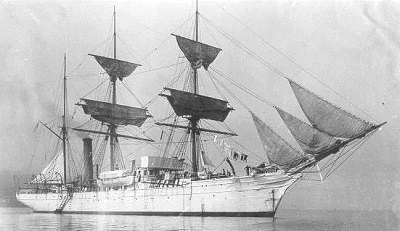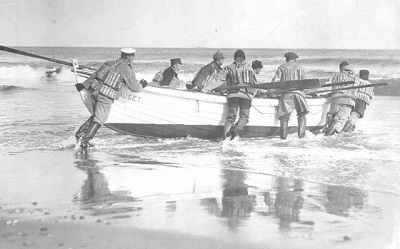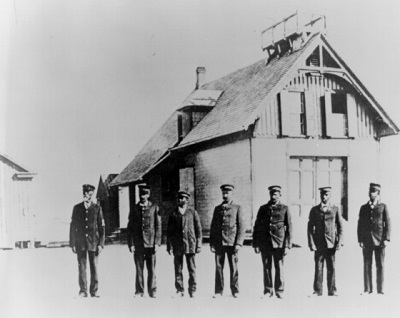The Coast Guard back in 1790
2015 marks the 225th birthday of the United States Coast Guard.
By Scott Price
When many think about the Coast Guard, they think of the modern, sea-going service that remains ‘Always Ready’ to answer calls for help. But where did our Nation’s Coast Guard come from?
The Coast Guard traces its history directly from the U.S. Revenue Cutter Service, or RCS, created on August 4, 1790 to protect the nation’s revenue laws at sea and to discourage smuggling, which had become a national pastime.
Established first and foremost as a maritime law enforcement agency, the RCS, with its small fleet of cutters and sailors, ably demonstrated a talent for carrying out a growing and diverse set of missions as the service grew along with the nation it served.
Rather than being controlled by a centralized headquarters, during these early years each RCS cutter and crew received direction from the local Collector of Customs. It was therefore a decentralized service, with the crews drawn primarily from the local mariner community, making the RCS crews a part of the towns and cities in which they were based.
 This lack of centralized control and difficulties in communications left much discretion to each cutter’s commanding officers in the performance of their duties, especially when they were out to sea. This self-reliant culture is one legacy still with the Coast Guard today, where crews are often instructed to rely on their training and experience during decision making processes. Leadership exhibited the trust in their personnel to exercise on-scene initiative, a trust still true today.
This lack of centralized control and difficulties in communications left much discretion to each cutter’s commanding officers in the performance of their duties, especially when they were out to sea. This self-reliant culture is one legacy still with the Coast Guard today, where crews are often instructed to rely on their training and experience during decision making processes. Leadership exhibited the trust in their personnel to exercise on-scene initiative, a trust still true today.
These early commanding officers who established this legacy proved to be dedicated public servants, many whose names became famous with their exploits, including Josiah Sturgis, John Faunce, Charles Shoemaker, Ellsworth Bertholf and Michael Healy, among others. Many cutters that they commanded also gained national renown, cutters with such storied names as Pickering, Hamilton, Harriet Lane and Bear.
Many of the enlisted men who served aboard these and other cutters were not well known but served ably as well, with many lying in far-off graves after having made the ultimate sacrifice in the service of their country. Crewmen like Seaman C. C. Mauethrop of the cutter Commodore Perry who gave his life for his shipmates and now lies in a cemetery in Unalaska. Their dedication to the service of others is carried on to this day by the Coast Guard’s enlisted force.
The RCS survived tough budget times and outright efforts to abolish it by continually proving its worth to political leaders and the nation. It proved to be a versatile service, adaptable to new missions and new national priorities – sometimes with little advance warning, a trait that also continues to this day.
Some of the service’s new duties included protecting the nation during wars, starting with the Quasi-War with France in 1798 up through most of the nation’s wars since that time. Other duties followed, such as setting sail during winter weather to rescue those in peril at sea beginning in 1831, exploring and then establishing the national government’s presence in Alaska in 1867, enforcing national law in times of crisis, such as the 1832 Nullification crisis, to mapping the location of icebergs on the North Atlantic after the sinking of the RMS Titanic in 1912.
 Cutters patrolled regattas, transported officials, protected wildlife and the environment, prevented smuggling, attacked pirates, carried out anti-slavery patrols, enforced quarantines and assisted other government agencies in carrying out a wide range of missions. Indeed one of the hallmarks of the RCS was its ability to work with other agencies effectively, including the U.S. Navy, U.S. Army, Coast Survey, the Lighthouse Service, and the Life-Saving Service, the latter two being close cousins to the RCS.
Cutters patrolled regattas, transported officials, protected wildlife and the environment, prevented smuggling, attacked pirates, carried out anti-slavery patrols, enforced quarantines and assisted other government agencies in carrying out a wide range of missions. Indeed one of the hallmarks of the RCS was its ability to work with other agencies effectively, including the U.S. Navy, U.S. Army, Coast Survey, the Lighthouse Service, and the Life-Saving Service, the latter two being close cousins to the RCS.
Today’s Coast Guard gained a larger mission set when the RCS merged with the U.S. Life-Saving Service, or LSS, in 1915. The LSS was a civilian humanitarian organization dedicated to saving life and property at sea.
With its history tracing back to the years prior to the Civil War, it had become, by 1915, a large, well organized service based at small stations that dotted the nation’s coastlines. The LSS crews excelled at performing rescues at sea in almost any weather. Drilling by day in their rescue techniques, including launching lifeboats through the surf directly from the beach, to firing their Lyle guns to set up a rescue hoist to vessels grounded near shore, they were always ready to risk their lives to save others.
Some names still echo down through history, including many that came from a long line of surfmen from the same families who dedicated their lives to the service of their nation and their countrymen.
Such family names included the Midgetts, Collins, Berry and Etheridge. The Coast Guard honors these heroes and their service to this day by continuing to name cutters after them. Names such as Richard Etheridge, the first African-American Keeper, Joshua James, Bailey T. Barco, Benjamin B. Dailey and Lawrence O. Lawson are all carried forward on the transom of Coast Guard Cutters.
 These lifesavers were assisted on a number of levels by officers of the RCS, who inspected the crews, the stations and the equipment and made personnel recommendations, leading to very close ties between the two services. One RCS officer, Charles Shoemaker, made history by suggesting to the LSS’s one and only chief, Sumner Kimball, to hire African-American Surfman Richard Etheridge, to command the Pea Island station in North Carolina in 1880 when the Nation itself was in the grip of Jim Crow.
These lifesavers were assisted on a number of levels by officers of the RCS, who inspected the crews, the stations and the equipment and made personnel recommendations, leading to very close ties between the two services. One RCS officer, Charles Shoemaker, made history by suggesting to the LSS’s one and only chief, Sumner Kimball, to hire African-American Surfman Richard Etheridge, to command the Pea Island station in North Carolina in 1880 when the Nation itself was in the grip of Jim Crow.
The LSS was a service that was local in nature similar to the RCS, having been established in or near the communities where they served.
These communities knew the sailors, ships and waters for which they were responsible, a tradition that continues with today’s Coast Guard stations and the service as a whole.
From 1871 to 1914, more than 178,000 people received services from these “Life-Savers.”
The Coast Guard’s search and rescue abilities trace their lineage through the historic work of the LSS and, along with the RCS, a foundation upon which today’s Coast Guard carries out most of its many missions and responsibilities was laid.
The opinions expressed herein are the author's and not necessarily those of The Maritime Executive.
